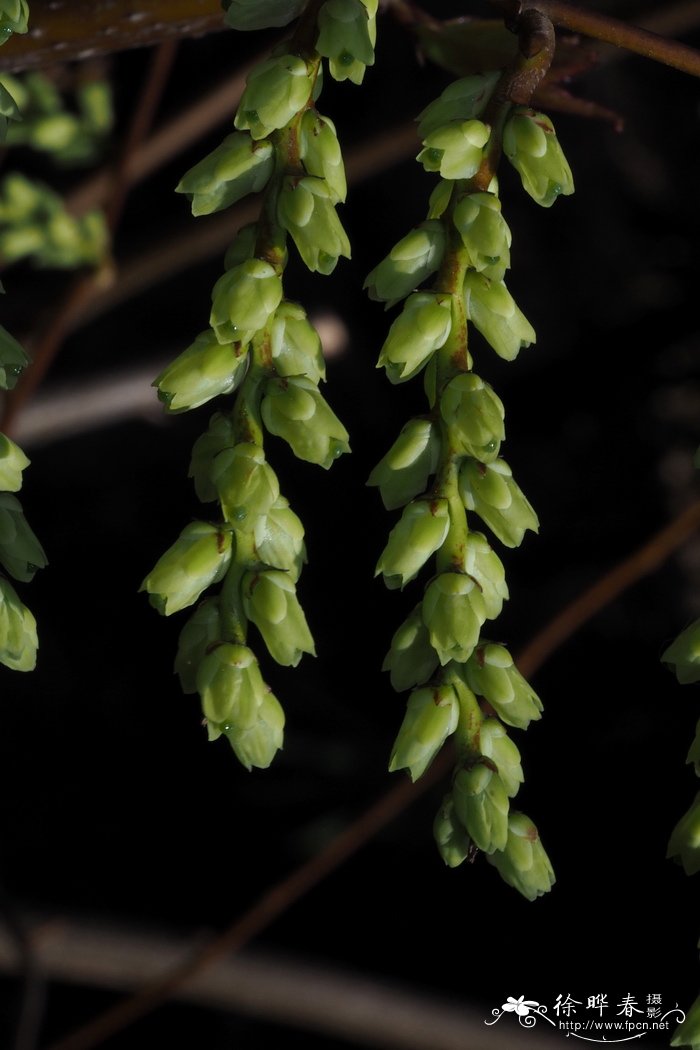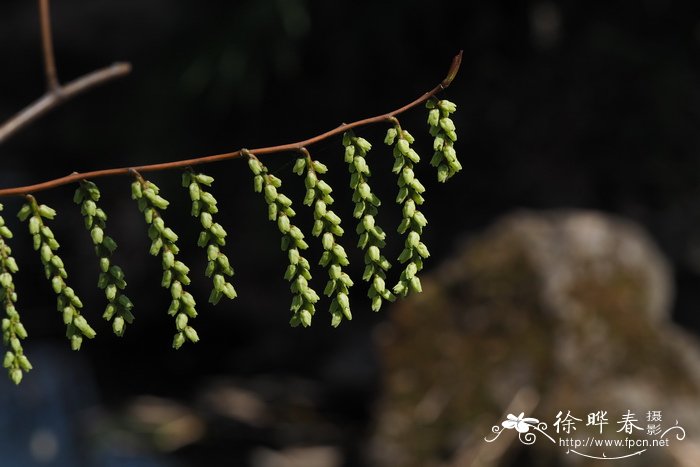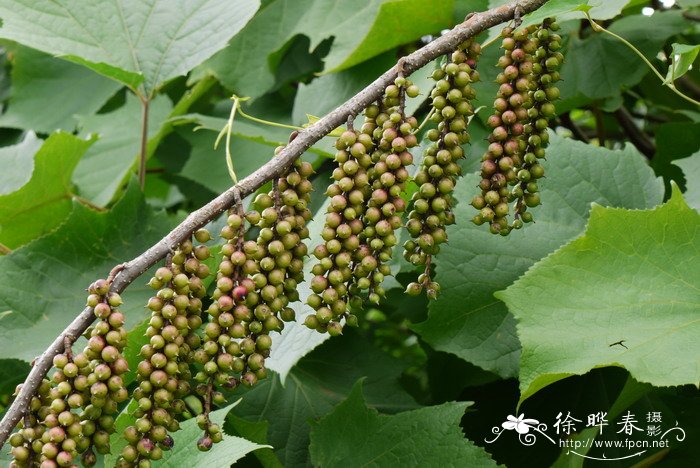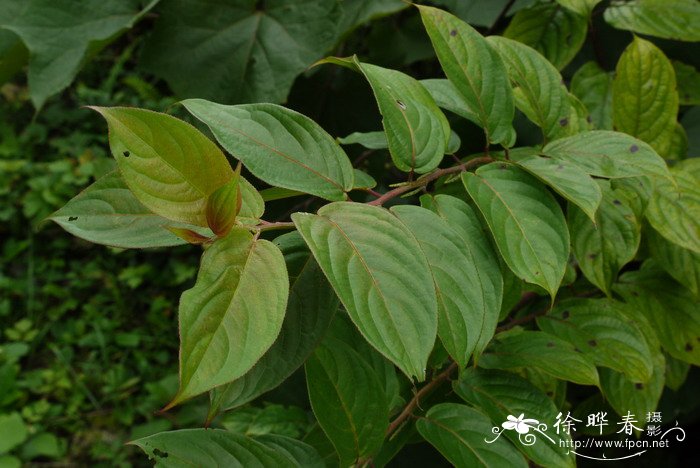中国旌节花Stachyurus chinensis
中文名(Chinese Name):中国旌节花
学名(Scientific Name):Stachyurus chinensis Franch.
英文名(English Common Name):
别名(Chinese Common Name):旌节花
异名(Synonym):Stachyurus chinensis var. latus H. L. Li Stachyurus chinensis var. cuspidatus H. L. Li Stachyurus duclouxii Pit. Stachyurus caudatilimbus C. Y. Wu et S. K. Chen Stachyurus chinensis subsp. cuspidatus (H. L. Li) Y. C. Tang et Y. L. Cao Stachyurus chinensis subsp. latus (H. L. Li) Y. C. Tang et Y. L. Cao Stachyurus sigeyosii Masam.
科属(Family & Genus):旌节花科(Stachyuraceae)旌节花属
形态特征(Description):落叶灌木,高2-4米。树皮光滑紫褐色或深褐色;小枝粗状,圆柱形,具淡色椭圆形皮孔。叶于花后发出,互生,纸质至膜质,卵形,长圆状卵形至长圆状椭圆形,长5-12厘米,宽3-7厘米,先端渐尖至短尾状渐尖,基部钝圆至近心形,边缘为圆齿状锯齿,侧脉5-6对,在两面均凸起,细脉网状,上面亮绿色,无毛,下面灰绿色,无毛或仅沿主脉和侧脉疏被短柔毛,后很快脱落;叶柄长1-2厘米,通常暗紫色。穗状花序腋生,先叶开放,长5-10厘米,无梗;花黄色,长约7毫米,近无梗或有短梗;苞片1枚,三角状卵形,顶端急尖,长约3毫米;小苞片2枚,卵形,长约2厘米;萼片4枚,黄绿色,卵形,长约3:5毫米,顶端钝;花瓣4枚,卵形,长约6.5毫米,顶端圆形;雄蕊8枚,与花瓣等长,花药长圆形,纵裂,2室;子房瓶状,连花柱长约6毫米,被微柔毛,柱头头状,不裂。果实圆球形,直径6-7厘米,无毛,近无梗,基部具花被的残留物。花粉粒球形或近球形,赤道面观为近圆形或圆形,极面观为三裂圆形或近圆形,具三孔沟。染色体数目2n=24。花期3-4月,果期5-7月。
分布(Distribution):产河南、陕西、西藏、浙江、安徽、江西、湖南、湖北、四川、贵州、福建、广东、广西和云南,生于海拔400-3000米的山坡谷地林中或林缘。越南北部也有分布。
用途(Use):
引自中国植物志英文版:FOC Vol. 13 Page 138, 140
Stachyurus chinensis Franchet, J. Bot. (Morot). 12: 254. 1898.
中国旌节花 zhong guo jing jie hua| Stachyuraceae | Stachyurus
Stachyurus caudatilimbus C. Y. Wu ex S. K. Chen; S. chinensis subsp. cuspidatus (H. L. Li) Y. C. Tang & Y. L. Cao; S. chinensis var. cuspidatus H. L. Li; S. chinensis subsp. latus (H. L. Li) Y. C. Tang & Y. L. Cao; S. chinensis var. latus H. L. Li; S. duclouxii Pitard ex Chung; S. sigeyosii Masamune.
Shrubs deciduous, 2-4 m tall. Petiole 1-2 cm; leaf blade ovate or oblong-ovate to oblong-elliptic, or suborbicular, 5-12 × 3-7 cm, papery to membranous, abaxially glabrous or sparsely pubescent along midvein and lateral veins, adaxially glabrous, lateral veins 5- or 6-paired, raised on both sides, base usually subcordate, or obtuse, margin crenate-serrate, apex acuminate to shortly caudate-acuminate, or rarely retuse. Spikes 5-10 cm. Flowers opening before leaves appear, yellow, ca. 7 mm, subsessile or shortly pedicellate; bract triangular-ovate, ca. 3 mm, apex acute; bracteoles ovate, ca. 2 cm. Sepals yellow-green, ovate, ca. 3.5 mm, apex obtuse. Petals ovate, ca. 6.5 mm, apex rounded. Ovary bottle-shaped, puberulous; style ca. 2 mm. Fruit globose, 6-7 mm in diam., glabrous. Fl. Mar-Apr, fr. May-Jul. 2n = 24*.
● Forests, thickets, forest margins; 400-3000 m. Anhui, Chongqing, Fujian, Gansu, Guangdong, Guangxi, Guizhou, Henan, Hubei, Hunan, Jiangxi, Shaanxi, Sichuan, Taiwan, Yunnan, Zhejiang.
This most widely distributed species in the genus is very highly polymorphic in the shape, size, and apices of the leaves. The apices of the leaves are highly variable, but the variation seems to be continuous. The bases of the leaves are usually subcordate, and seemingly the most stable diagnostic character for this species. The plants from Taiwan are more narrowly oblong-elliptic, but show no essential differences from those of Fujian, Guangdong, and Jiangxi. From the subcordate leaf bases of the Taiwan plants, it seems more reasonable to refer them to Stachyurus chinensis than to S. himalaicus. These two species are usually distinguishable by leaf shape, particularly the leaf base, but the plants from SW Sichuan, SE Xizang, and NW Yunnan cannot be distinctly differentiated from those of the Himalayan region. In a broader sense, the two species may be better treated as conspecific.




(责任编辑:徐晔春)
学名(Scientific Name):Stachyurus chinensis Franch.
英文名(English Common Name):
别名(Chinese Common Name):旌节花
异名(Synonym):Stachyurus chinensis var. latus H. L. Li Stachyurus chinensis var. cuspidatus H. L. Li Stachyurus duclouxii Pit. Stachyurus caudatilimbus C. Y. Wu et S. K. Chen Stachyurus chinensis subsp. cuspidatus (H. L. Li) Y. C. Tang et Y. L. Cao Stachyurus chinensis subsp. latus (H. L. Li) Y. C. Tang et Y. L. Cao Stachyurus sigeyosii Masam.
科属(Family & Genus):旌节花科(Stachyuraceae)旌节花属
形态特征(Description):落叶灌木,高2-4米。树皮光滑紫褐色或深褐色;小枝粗状,圆柱形,具淡色椭圆形皮孔。叶于花后发出,互生,纸质至膜质,卵形,长圆状卵形至长圆状椭圆形,长5-12厘米,宽3-7厘米,先端渐尖至短尾状渐尖,基部钝圆至近心形,边缘为圆齿状锯齿,侧脉5-6对,在两面均凸起,细脉网状,上面亮绿色,无毛,下面灰绿色,无毛或仅沿主脉和侧脉疏被短柔毛,后很快脱落;叶柄长1-2厘米,通常暗紫色。穗状花序腋生,先叶开放,长5-10厘米,无梗;花黄色,长约7毫米,近无梗或有短梗;苞片1枚,三角状卵形,顶端急尖,长约3毫米;小苞片2枚,卵形,长约2厘米;萼片4枚,黄绿色,卵形,长约3:5毫米,顶端钝;花瓣4枚,卵形,长约6.5毫米,顶端圆形;雄蕊8枚,与花瓣等长,花药长圆形,纵裂,2室;子房瓶状,连花柱长约6毫米,被微柔毛,柱头头状,不裂。果实圆球形,直径6-7厘米,无毛,近无梗,基部具花被的残留物。花粉粒球形或近球形,赤道面观为近圆形或圆形,极面观为三裂圆形或近圆形,具三孔沟。染色体数目2n=24。花期3-4月,果期5-7月。
分布(Distribution):产河南、陕西、西藏、浙江、安徽、江西、湖南、湖北、四川、贵州、福建、广东、广西和云南,生于海拔400-3000米的山坡谷地林中或林缘。越南北部也有分布。
用途(Use):
引自中国植物志英文版:FOC Vol. 13 Page 138, 140
Stachyurus chinensis Franchet, J. Bot. (Morot). 12: 254. 1898.
中国旌节花 zhong guo jing jie hua| Stachyuraceae | Stachyurus
Stachyurus caudatilimbus C. Y. Wu ex S. K. Chen; S. chinensis subsp. cuspidatus (H. L. Li) Y. C. Tang & Y. L. Cao; S. chinensis var. cuspidatus H. L. Li; S. chinensis subsp. latus (H. L. Li) Y. C. Tang & Y. L. Cao; S. chinensis var. latus H. L. Li; S. duclouxii Pitard ex Chung; S. sigeyosii Masamune.
Shrubs deciduous, 2-4 m tall. Petiole 1-2 cm; leaf blade ovate or oblong-ovate to oblong-elliptic, or suborbicular, 5-12 × 3-7 cm, papery to membranous, abaxially glabrous or sparsely pubescent along midvein and lateral veins, adaxially glabrous, lateral veins 5- or 6-paired, raised on both sides, base usually subcordate, or obtuse, margin crenate-serrate, apex acuminate to shortly caudate-acuminate, or rarely retuse. Spikes 5-10 cm. Flowers opening before leaves appear, yellow, ca. 7 mm, subsessile or shortly pedicellate; bract triangular-ovate, ca. 3 mm, apex acute; bracteoles ovate, ca. 2 cm. Sepals yellow-green, ovate, ca. 3.5 mm, apex obtuse. Petals ovate, ca. 6.5 mm, apex rounded. Ovary bottle-shaped, puberulous; style ca. 2 mm. Fruit globose, 6-7 mm in diam., glabrous. Fl. Mar-Apr, fr. May-Jul. 2n = 24*.
● Forests, thickets, forest margins; 400-3000 m. Anhui, Chongqing, Fujian, Gansu, Guangdong, Guangxi, Guizhou, Henan, Hubei, Hunan, Jiangxi, Shaanxi, Sichuan, Taiwan, Yunnan, Zhejiang.
This most widely distributed species in the genus is very highly polymorphic in the shape, size, and apices of the leaves. The apices of the leaves are highly variable, but the variation seems to be continuous. The bases of the leaves are usually subcordate, and seemingly the most stable diagnostic character for this species. The plants from Taiwan are more narrowly oblong-elliptic, but show no essential differences from those of Fujian, Guangdong, and Jiangxi. From the subcordate leaf bases of the Taiwan plants, it seems more reasonable to refer them to Stachyurus chinensis than to S. himalaicus. These two species are usually distinguishable by leaf shape, particularly the leaf base, but the plants from SW Sichuan, SE Xizang, and NW Yunnan cannot be distinctly differentiated from those of the Himalayan region. In a broader sense, the two species may be better treated as conspecific.
(责任编辑:徐晔春)
踩一下[1]

顶一下[1]